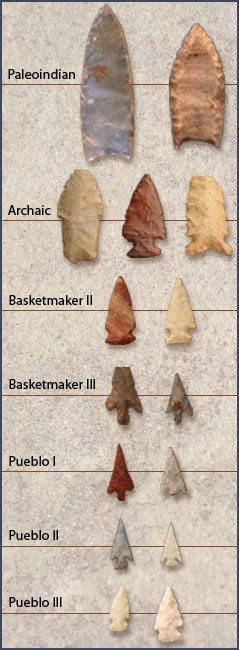Peoples of the Mesa Verde Region
What is a Projectile Point?
Projectile point styles in the Mesa Verde region, Paleoindian through Pueblo III periods. Archaeologists use the term projectile point to describe a broad category of pointed tools that were used for different purposes from ancient times through the historic period. They come in many sizes and shapes and are made of a wide variety of materials, including stone, wood, shell, glass, and metal. The ancient projectile points archaeologists find in the Mesa Verde region are made of stone. Most projectile points were attached, or hafted, to shafts made of wood, reed, or bone. Depending on the length of the shaft, the tool is classified as a spear or arrow, both of which were used for hunting or as weapons. In the Mesa Verde region, spears were used during the Paleoindian, Archaic, and Basketmaker II periods; the bow and arrow was introduced during Basketmaker III times. However, not until archaeologists began examining stone tools under the microscope did they realize that some projectile points were used for different purposes. Various activities—like cutting, scraping, or piercing—cause different kinds of damage to the tips and edges of stone tools. Microscopic studies of this damage show that some "projectile points" were actually used as knives for cutting. Under magnification, it can be seen that the edges, not the tips, of these tools were damaged by a back-and-forth sawing motion. Because projectile point styles changed over time, archaeologists can use these artifacts to date sites within very broad time periods. The photograph to the right shows a sample of projectile points dating from the Paleoindian through the Pueblo III periods. |
Acknowledgments | Illustration credits | To borrow, cite, or request permission | Please take our survey! Title page for Peoples of the Mesa Verde Region |
 DONATE TODAY
DONATE TODAY
